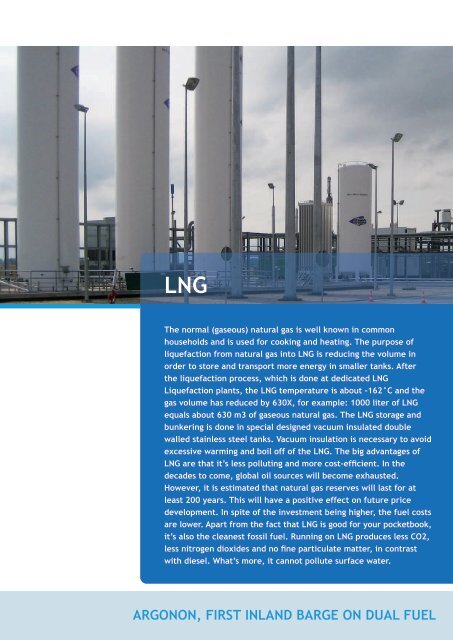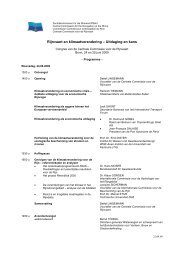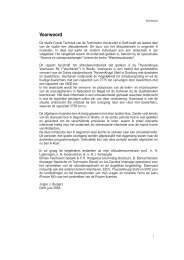ARgonon, susTAinAblE ship - Informatie Binnenvaart
ARgonon, susTAinAblE ship - Informatie Binnenvaart
ARgonon, susTAinAblE ship - Informatie Binnenvaart
- No tags were found...
You also want an ePaper? Increase the reach of your titles
YUMPU automatically turns print PDFs into web optimized ePapers that Google loves.
LNG as fuelfor inland navigationDual FuelThe propulsion engines that are currently suitable for natural gas are‘Dual-Fuel’. This means that the engine runs on natural gas and diesel.Argonon has 2 standard Caterpillar 3512 engines that use approximately 20%diesel in order to ignite the gas mixture. These engines have been modifiedby Pon Power so that the combustion air is enriched with natural gas.This leads to a Dual Fuel engine needing less diesel to produce the requiredpower and keeps the same stability, responsiveness in all conditions.LNGThe normal (gaseous) natural gas is well known in commonhouseholds and is used for cooking and heating. The purpose ofliquefaction from natural gas into LNG is reducing the volume inorder to store and transport more energy in smaller tanks. Afterthe liquefaction process, which is done at dedicated LNGLiquefaction plants, the LNG temperature is about -162°C and thegas volume has reduced by 630X, for example: 1000 liter of LNGequals about 630 m3 of gaseous natural gas. The LNG storage andbunkering is done in special designed vacuum insulated doublewalled stainless steel tanks. Vacuum insulation is necessary to avoidexcessive warming and boil off of the LNG. The big advantages ofLNG are that it’s less polluting and more cost-efficient. In thedecades to come, global oil sources will become exhausted.However, it is estimated that natural gas reserves will last for atleast 200 years. This will have a positive effect on future pricedevelopment. In spite of the investment being higher, the fuel costsare lower. Apart from the fact that lng is good for your pocketbook,it’s also the cleanest fossil fuel. Running on LNG produces less CO2,less nitrogen dioxides and no fine particulate matter, in contrastwith diesel. What’s more, it cannot pollute surface water.Gas generatorsGenerators can also easily operate on natural gas. Various inland navigationcompanies already have gas generators in their portfolio that are derivedfrom truck engines. There are already many trucks on the road that arerunning on natural gas. Progress in this is very rapid and will certainly find itsway into inland navigation. And there are also gas-turbine engines that arevery suitable for <strong>ship</strong> use. Argonon has two Capstone gas turbines to powerthe electrical system.LegislationAccording to legislation, it is not yet permitted to use natural gas as a fuel ininland navigation. However, for classification bureaus this is not a problem asmaritime has been using LNG for more than 30 years already. If classificationapproves a LNG proposal, this can then demonstrate equivalence with diesel.Based on this, the vessel can be granted an exemption until the regulationsare amended. Because of its vast environmental potential, and thus its socialimportance, it is high on the European agenda. However, amending theregulations demands patience.BunkeringThe availability of liquefied natural gas is in development and is going toreally take off in the years to come. Many bunker stations throughout thecountry are busy applying to construct a LNG bunker facility. This is alsobeing financially encouraged by the government. Until these facilities arethere, it is possible to bunker with a tanker at designated locations. Thequantities needed vary according to vessel. A water-bus can run for a week on3 m3 while Argonon needs ± 30 m3 to travel to and from Basel withoutbunkering.PossibilitiesOnce the bunkering infrastructure and regulations are in order, there will bemany LNG applications seen in inland navigation. Actually, all vessels, includingexisting <strong>ship</strong>s, are suitable for LNG. The biggest challenge is installingthe tank. There are many variations of engine possible: from modifying anexisting engine to a complete gas-electric propulsion unit. The possibilitiesdiffer per vessel.argonon, First inland barge on dual fuel




